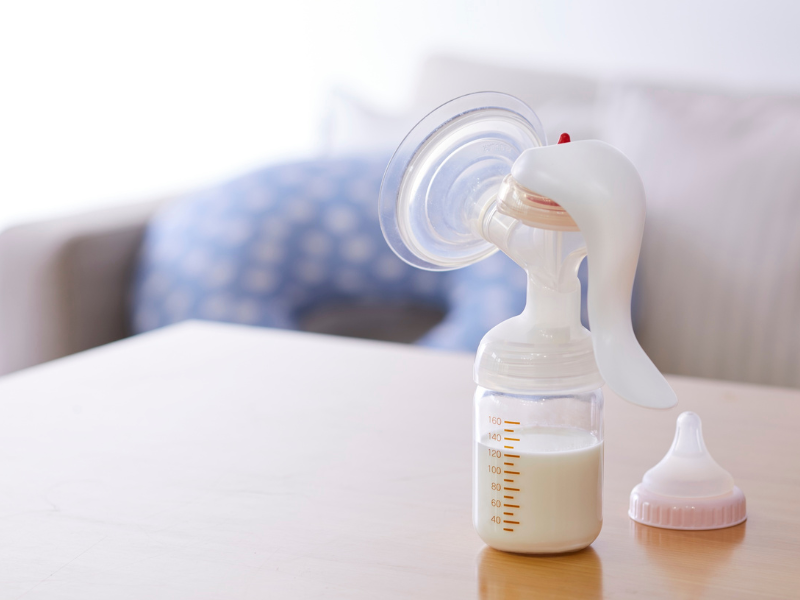Wondering how much breast milk to offer per feed? Our Milk Intake Calculator gives daily and per-feed estimates, with a paced feeding toggle to match your baby’s natural pace.
This guide is for mothers who are expressing and bottle-feeding breast milk. If you are breastfeeding directly, it’s nearly impossible to measure intake (and unnecessary if your baby is thriving).
How Much Expressed Breast Milk Does My Baby Need?
Many new moms wonder how much milk to put in a bottle when feeding expressed breast milk. Our milk intake calculator helps you estimate the right amount for your baby based on age and weight, and even feeding method (paced or not).
Why We Include a “Paced Bottle Feeding” Option
Not all babies feed the same way, and neither do all parents. Some babies drink very quickly from a bottle, which can lead to overfeeding, gas, or discomfort. Paced bottle feeding is a method that helps slow your baby’s intake so they can better recognize hunger and fullness cues, mimicking the natural pace of breastfeeding.
Our milk intake calculator includes a toggle for paced bottle feeding so you can adjust the per-feed amount to match your baby’s feeding style. If you select paced feeding, the calculator may suggest slightly smaller amounts per feed spread over a longer period—helping your baby feed comfortably and safely.
Including this option allows parents to make the calculator more personalized and practical for real-life feeding scenarios.
The good news? Research shows that between 1 and 6 months, a baby’s daily milk intake doesn’t actually change much.
Your body is remarkable—it adjusts the nutrient composition and calorie density of your breast milk as your baby grows. So even though your little one gets bigger, they usually don’t need larger and larger volumes. Instead, your milk gets richer.
IMPORTANT! Babies remove milk more effectively than pumps do, so don’t compare pumping output with what your baby gets at the breast. The calculator below is meant for babies who are exclusively fed expressed breast milk by bottle.
If you’re worried about whether your baby is getting enough, check our guide:
Milk Intake Calculator
Estimate how much expressed breast milk to offer per feed and per day.
Average Daily Expressed Breast Milk Intake
Each baby is unique, but these averages can give you a good starting point. Always watch your baby’s hunger and fullness cues—never force them to finish a bottle.
| Baby’s Age | Approx. Amount per Feeding (mL) | Feeds per Day | Total Daily Intake (mL) |
|---|---|---|---|
| Days 1–3 | 5–10 | 8–12 | 30–60 |
| Days 4–7 | 45–60 | 8–12 | 300–450 |
| Week 2 | 60–90 | 8–12 | 450–600 |
| Week 3 | 80–100 | 8–12 | 550–700 |
| Weeks 4–5 | 90–120 | 8–12 | 600–750 |
| 6–8 Weeks | 95–125 | 7–9 | 700–850 |
| 2–4 Months | 100–150 | 6–8 | 750–900 |
| 4–6 Months | 120–150 | 6–8 | 750–900 |
| 6–9 Months | 120–150 | 5–7 | 600–750 |
| 9–12 Months | 120–140 | 4–6 | 500–700 |
Tip: From 1–6 months, most exclusively breastfed babies take in about 750 mL per day (25 oz), give or take 150 mL (5 oz). This doesn’t change much until solids are introduced.
What Can Change Your Baby’s Milk Intake?
- Growth spurts: Babies often feed more at 7–14 days, 2 months, 4 months, and 6 months.
- Baby’s sex: Boys may drink 30–60 mL more per day on average.
- Starting solids: Milk remains the main food until 12 months, but intake may dip slightly.
- Reverse cycling: Some babies feed more at night if separated from mom during the day.
- Combination feeding: Formula volumes are fixed, while breast milk adapts naturally.

What Affects How Much You Express?
Remember: pumped volume ≠ baby’s intake. Pumping output can vary depending on:
- Frequency of milk removal (more often = more milk).
- How much formula you give alongside breast milk.
- Time of day (supply is often higher in the morning).
- Stress (adrenaline can block letdown).
- Pump quality and fit (a good flange fit matters).
Recognizing Hunger Cues
Feeding on demand is best. Watch for early signs, not just crying.
- Early cues: lip-licking, opening mouth, sucking hands or lips.
- Active cues: rooting, wriggling, fussing, breathing faster.
- Late cues: crying, frantic head-turning.
Try to feed during early or active hunger cues, before baby gets upset.
How to Know Your Baby Is Getting Enough
- Weight gain: Steady weight gain along growth curves.
- Wet diapers: 6+ wet diapers per day after the first week.
- Happy baby: Alert, satisfied after most feeds.
If these are on track—you’re doing perfectly!
Final Thoughts
Don’t get too caught up in the numbers. Use the chart and milk intake calculator as a guide, but always let your baby lead. Trust your instincts, watch hunger cues, and know that your breast milk naturally adjusts to your baby’s needs.
References
- American Academy of Pediatrics (AAP) – Exclusive breastfeeding recommended for first 6 months.
- KellyMom – How much milk does baby need?


